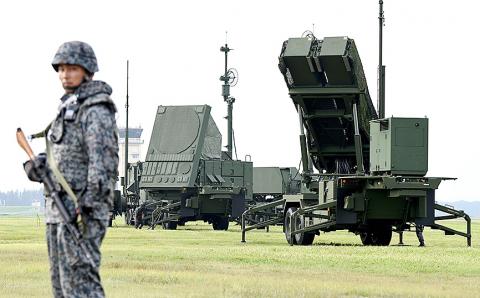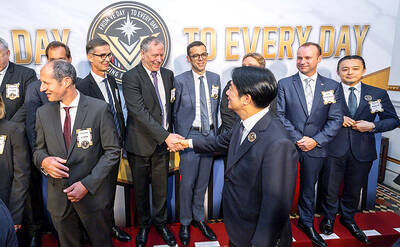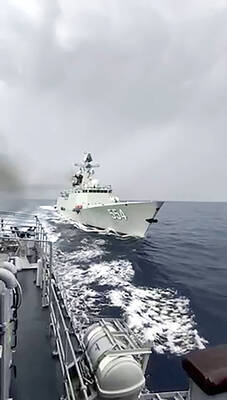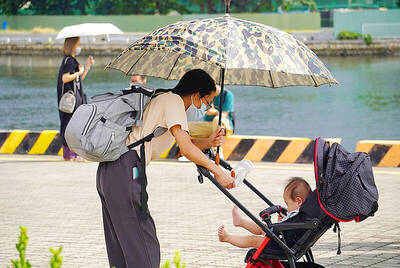The Japanese Ministry of Defense is seeking to more than double spending on missile defense, including purchases of costly US-made equipment, to defend against North Korean threats.
The record-high ¥5.3 trillion (US$47.84 billion) request for fiscal year 2019, approved yesterday by the ministry, is an increase of 2.1 percent from last year. Military spending has risen for seven consecutive years under Japanese Prime Minister Shinzo Abe.
Missile defense spending is to be increased from about ¥180 billion last year to ¥424 billion.

Photo: AFP
The overall government budget plan is to be submitted for Cabinet and parliamentary approval later this year.
The final budget could still grow, because the request did not include spending to reduce Okinawan communities’ burden of hosting many of 50,000 US troops stationed on the southern island and the cost of relocating some troops to the US territory of Guam.
A large chunk would buy a pair of land-based Aegis Ashore missile defense systems and the ship-to-air RIM-161 Standard Missile 3 Block IIA, which has expanded range and accuracy and was jointly developed by the US and Japan, as well as upgrades to fighter jets and destroyers to make them compatible with the advanced interceptors.
Japan has pushed harder to upgrade and bolster its missile and counterstrike capabilities, citing North Korea’s nuclear and missile threat.
In an annual military review released earlier this week, the ministry emphasized the need to further improve missile defenses, because North Korea has not taken concrete steps to denuclearize, despite its pledge to do so.
Opposition to Japan’s big spending on missile defense has risen since Pyongyang suspended missile tests this year as it made diplomatic overtures to the US and South Korea.
Japan’s use of US weapons is beneficial to its alliance with Washington, but opponents have said that it benefits the US arms industry, but not struggling Japanese makers.
In the budget request, Japan’s arms purchases under the US Department of Defense’s Foreign Military Sales program would jump 70 percent from last year to a record ¥692 billion.
Japan currently has a two-step missile defense system — interceptors on destroyers in the Sea of Japan and, if they fail, mobile surface-to-air MIM-104F Patriot missile batteries.
Technically, the setup can deal with falling debris or missiles fired at Japan, but is insufficient for high-altitude missiles or multiple attacks, experts have said, adding that a pair of Aegis Ashore systems could defend the entire nation and multiply missile defense.
The upgrade would cost ¥100 billion more than an earlier estimate, as Japan chose an expensive Lockheed Martin radar system that is reportedly capable of tracking and guiding interceptors against cruise missiles and other projectiles on a high-altitude trajectory.
It would take about six years for the system to become operational, ministry officials said.
However, it could also take longer, as the plan faces opposition from many residents at intended deployment sites — Akita in northern Japan and Yamaguchi in the southwest.

DEFENDING DEMOCRACY: Taiwan shares the same values as those that fought in WWII, and nations must unite to halt the expansion of a new authoritarian bloc, Lai said The government yesterday held a commemoration ceremony for Victory in Europe (V-E) Day, joining the rest of the world for the first time to mark the anniversary of the end of World War II in Europe. Taiwan honoring V-E Day signifies “our growing connections with the international community,” President William Lai (賴清德) said at a reception in Taipei on the 80th anniversary of V-E Day. One of the major lessons of World War II is that “authoritarianism and aggression lead only to slaughter, tragedy and greater inequality,” Lai said. Even more importantly, the war also taught people that “those who cherish peace cannot

Taiwanese Olympic badminton men’s doubles gold medalist Wang Chi-lin (王齊麟) and his new partner, Chiu Hsiang-chieh (邱相榤), clinched the men’s doubles title at the Yonex Taipei Open yesterday, becoming the second Taiwanese team to win a title in the tournament. Ranked 19th in the world, the Taiwanese duo defeated Kang Min-hyuk and Ki Dong-ju of South Korea 21-18, 21-15 in a pulsating 43-minute final to clinch their first doubles title after teaming up last year. Wang, the men’s doubles gold medalist at the 2020 and 2024 Olympics, partnered with Chiu in August last year after the retirement of his teammate Lee Yang

The Philippines yesterday criticized a “high-risk” maneuver by a Chinese vessel near the disputed Scarborough Shoal (Huangyan Island, 黃岩島) in a rare incident involving warships from the two navies. The Scarborough Shoal — a triangular chain of reefs and rocks in the contested South China Sea — has been a flash point between the countries since China seized it from the Philippines in 2012. Taiwan also claims the shoal. Monday’s encounter took place approximately 11.8 nautical miles (22km) southeast” of the Scarborough Shoal, the Philippine military said, during ongoing US-Philippine military exercises that Beijing has criticized as destabilizing. “The Chinese frigate BN 554 was

The number of births in Taiwan fell to an all-time monthly low last month, while the population declined for the 16th consecutive month, Ministry of the Interior data released on Friday showed. The number of newborns totaled 8,684, which is 704 births fewer than in March and the lowest monthly figure on record, the ministry said. That is equivalent to roughly one baby born every five minutes and an annual crude birthrate of 4.52 per 1,000 people, the ministry added. Meanwhile, 17,205 deaths were recorded, resulting in a natural population decrease of 8,521, the data showed. More people are also leaving Taiwan, with net